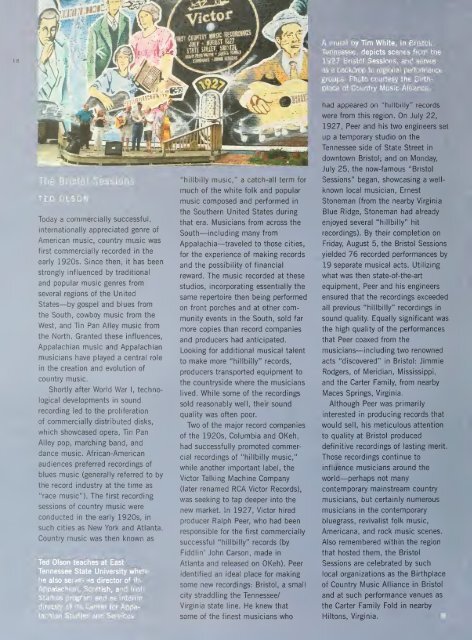SCOTLAND - Smithsonian Digital Repository - Smithsonian Institution
SCOTLAND - Smithsonian Digital Repository - Smithsonian Institution
SCOTLAND - Smithsonian Digital Repository - Smithsonian Institution
Create successful ePaper yourself
Turn your PDF publications into a flip-book with our unique Google optimized e-Paper software.
A mural by Tim White, in<br />
Bristol,<br />
Tennessee, depicts scenes from the<br />
1927 Bristol Sessions, and serves<br />
as a backdrop to regional performance<br />
groups. Photo courtesy the Birthplace<br />
of Country Music Alliance.<br />
1"iiTTf!nTlli<br />
TED OLSON<br />
Today a commercially successful,<br />
internationally appreciated genre of<br />
American music, country music was<br />
first commercially recorded in the<br />
early 1920s. Since then, it has been<br />
strongly influenced by traditional<br />
and popular music genres from<br />
several regions of the United<br />
States— by gospel and blues from<br />
the South, cowboy music from the<br />
West, and Tin Pan Alley music from<br />
the North. Granted these influences,<br />
Appalachian music and Appalachian<br />
musicians have played a central role<br />
in<br />
the creation and evolution of<br />
country music.<br />
Shortly after World War I, technological<br />
developments in<br />
sound<br />
recording led to the proliferation<br />
of commercially distributed disks,<br />
which showcased opera, Tm Pan<br />
Alley pop, marching band, and<br />
dance music. African-American<br />
audiences preferred recordings of<br />
blues music (generally referred to by<br />
the record industry at the time as<br />
"race music"). The first recording<br />
sessions of country music were<br />
conducted in the early 1920s, in<br />
such cities as New York and Atlanta.<br />
Country music was then known as<br />
Ted Olson teaches at East<br />
Tennessee State University where<br />
he also serves as director of its<br />
Appalachian, Scottish, and Irish<br />
Studies program and as interim<br />
director of its Center for Appalachian<br />
Studies and Services.<br />
"hillbilly music," a catch-all term for<br />
much of the white folk and popular<br />
music composed and performed in<br />
the Southern United States during<br />
that era. Musicians from across the<br />
South—including many from<br />
Appalachia—traveled to those cities,<br />
for the experience of making records<br />
and the possibility of financial<br />
reward. The music recorded at these<br />
studios, incorporating essentially the<br />
same repertoire then being performed<br />
on front porches and at other community<br />
events in the South, sold far<br />
more copies than record companies<br />
and producers had anticipated.<br />
Looking for additional musical talent<br />
to make more "hillbilly" records,<br />
producers transported equipment to<br />
the countryside where the musicians<br />
lived. While some of the recordings<br />
sold reasonably well, their sound<br />
quality was often poor.<br />
Two of the major record companies<br />
of the 1920s, Columbia and OKeh,<br />
had successfully promoted commercial<br />
recordings of "hillbilly music,"<br />
while another important label, the<br />
Victor Talking Machine Company<br />
(later renamed RCA Victor Records),<br />
was seeking to tap deeper into the<br />
new market. In 1927, Victor hired<br />
producer Ralph Peer, who had been<br />
responsible for the first commercially<br />
successful "hillbilly" records (by<br />
Fiddlin' John Carson, made in<br />
Atlanta and released on OKeh). Peer<br />
identified an ideal place for making<br />
some new recordings: Bristol, a small<br />
city straddling the Tennessee/<br />
Virginia state line.<br />
He knew that<br />
some of the finest musicians who<br />
naa appeared on "niiiDiiiy" recoras<br />
were from this region. On July 22,<br />
1927, Peer and his two engineers set<br />
up a temporary studio on the<br />
Tennessee side of State Street in<br />
downtown Bristol; and on Monday,<br />
July 25, the now-famous "Bristol<br />
Sessions" began, showcasing a wellknown<br />
local<br />
musician, Ernest<br />
Stoneman (from the nearby Virginia<br />
Blue Ridge, Stoneman had already<br />
enjoyed several "hillbilly"<br />
hit<br />
recordings). By their completion on<br />
Friday, August 5, the Bristol Sessions<br />
yielded 76 recorded performances by<br />
19 separate musical acts. Utilizing<br />
what was then state-of-the-art<br />
equipment, Peer and his engineers<br />
ensured that the recordings exceeded<br />
all previous "hillbilly" recordings in<br />
sound quality.<br />
Equally significant was<br />
the high quality of the performances<br />
that Peer coaxed from the<br />
musicians—including two renowned<br />
acts "discovered" in Bristol: Jimmie<br />
Rodgers, of Meridian, Mississippi,<br />
and the Carter Family, from nearby<br />
Maces Springs, Virginia.<br />
Although Peer was primarily<br />
interested in<br />
would sell,<br />
to quality at Bristol<br />
producing records that<br />
his meticulous attention<br />
produced<br />
definitive recordings of lasting merit.<br />
Those recordings continue to<br />
influence musicians around the<br />
world— perhaps not many<br />
contemporary mainstream country<br />
musicians, but certainly numerous<br />
musicians in the contemporary<br />
bluegrass, revivalist folk music,<br />
Americana, and rock music scenes.<br />
Also remembered within the region<br />
that hosted them, the Bristol<br />
Sessions are celebrated by such<br />
local organizations as the Birthplace<br />
of Country Music Alliance in<br />
Bristol<br />
and at such performance venues as<br />
the Carter Family Fold in<br />
Hiltons, Virginia.<br />
nearby
















